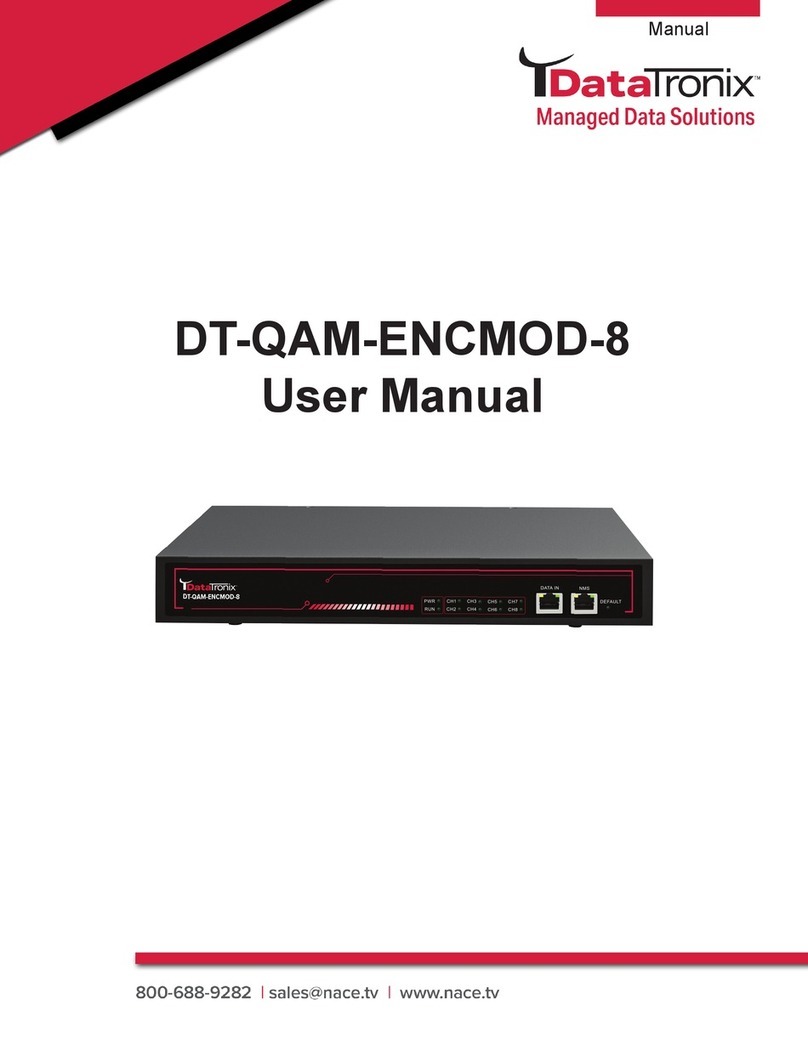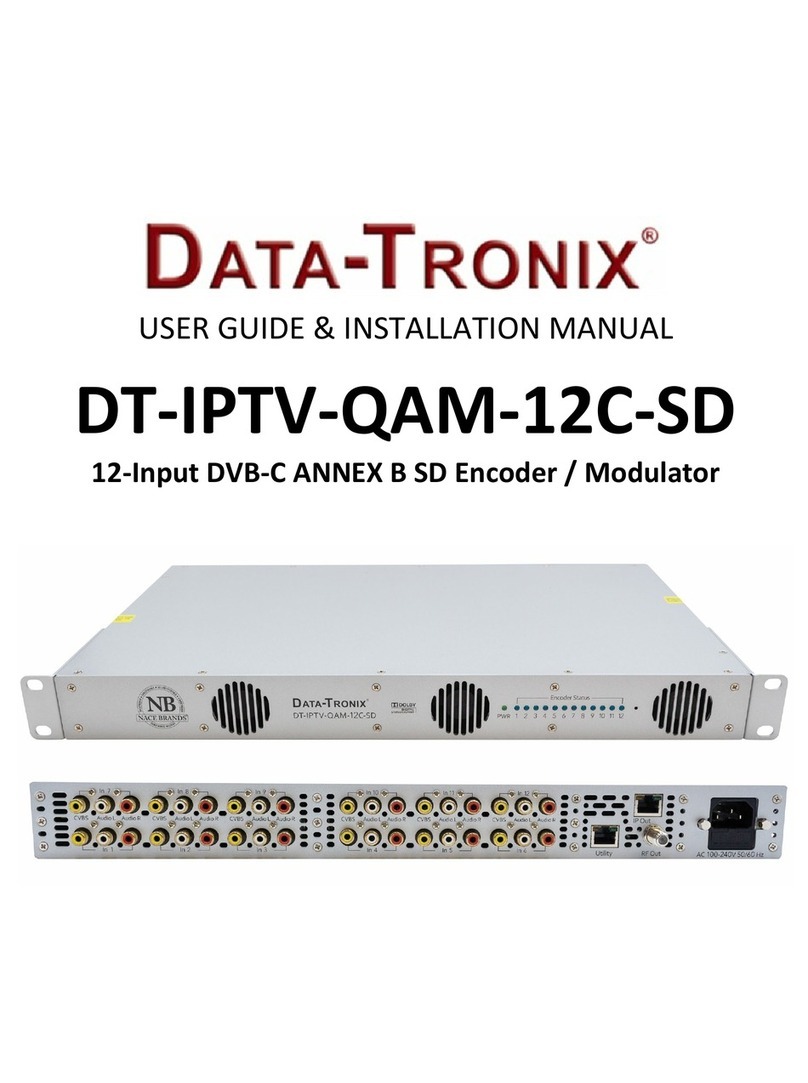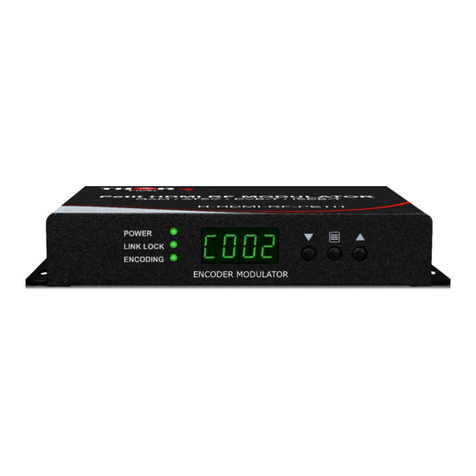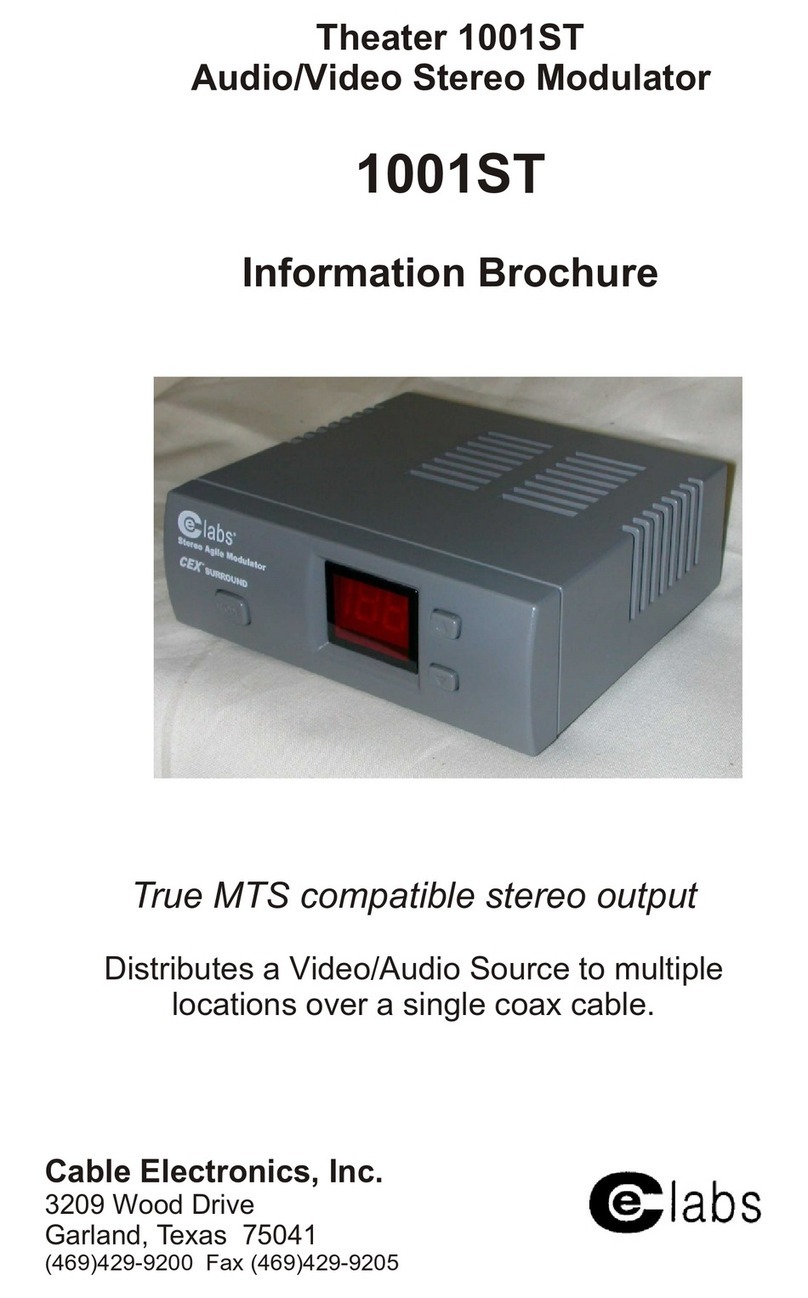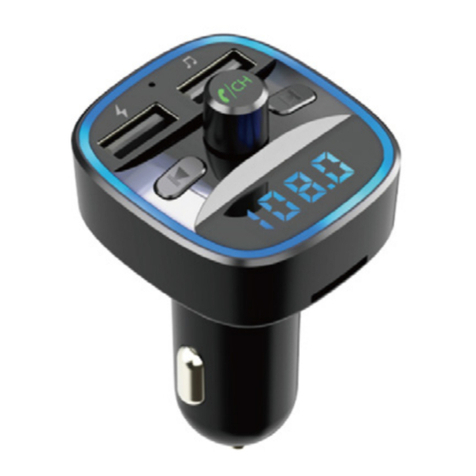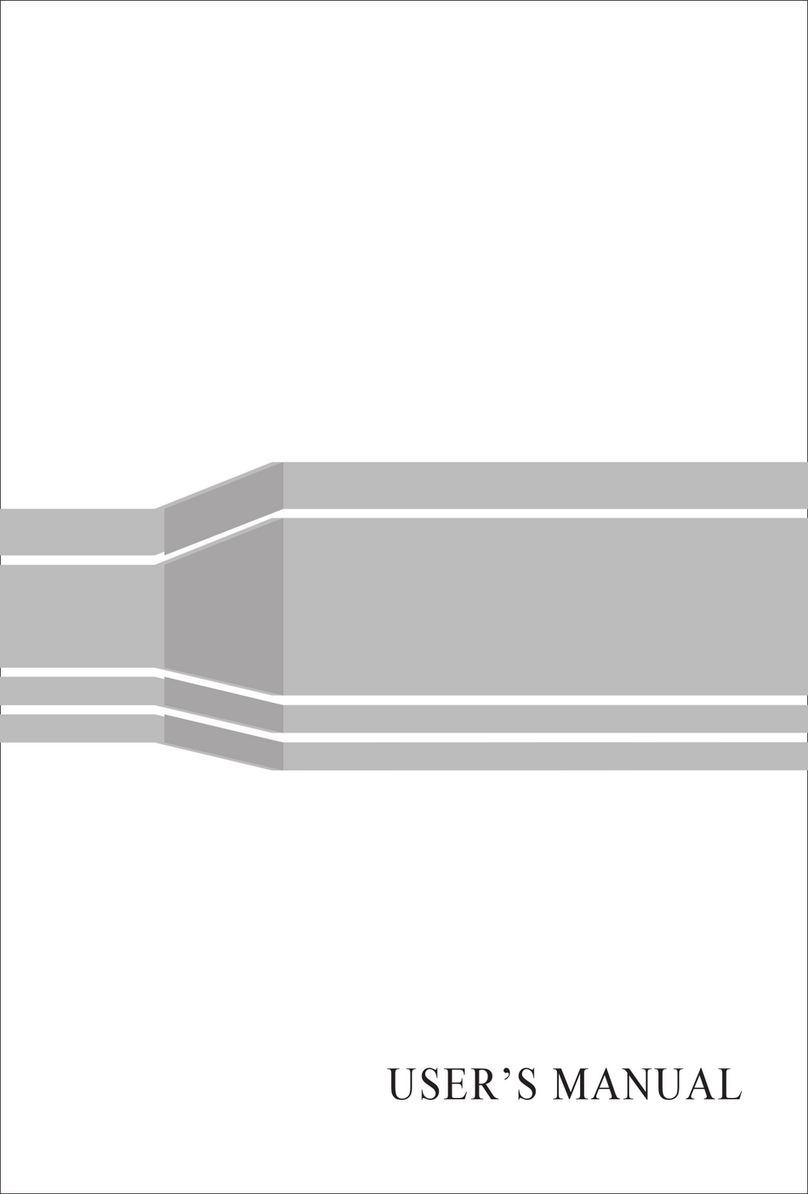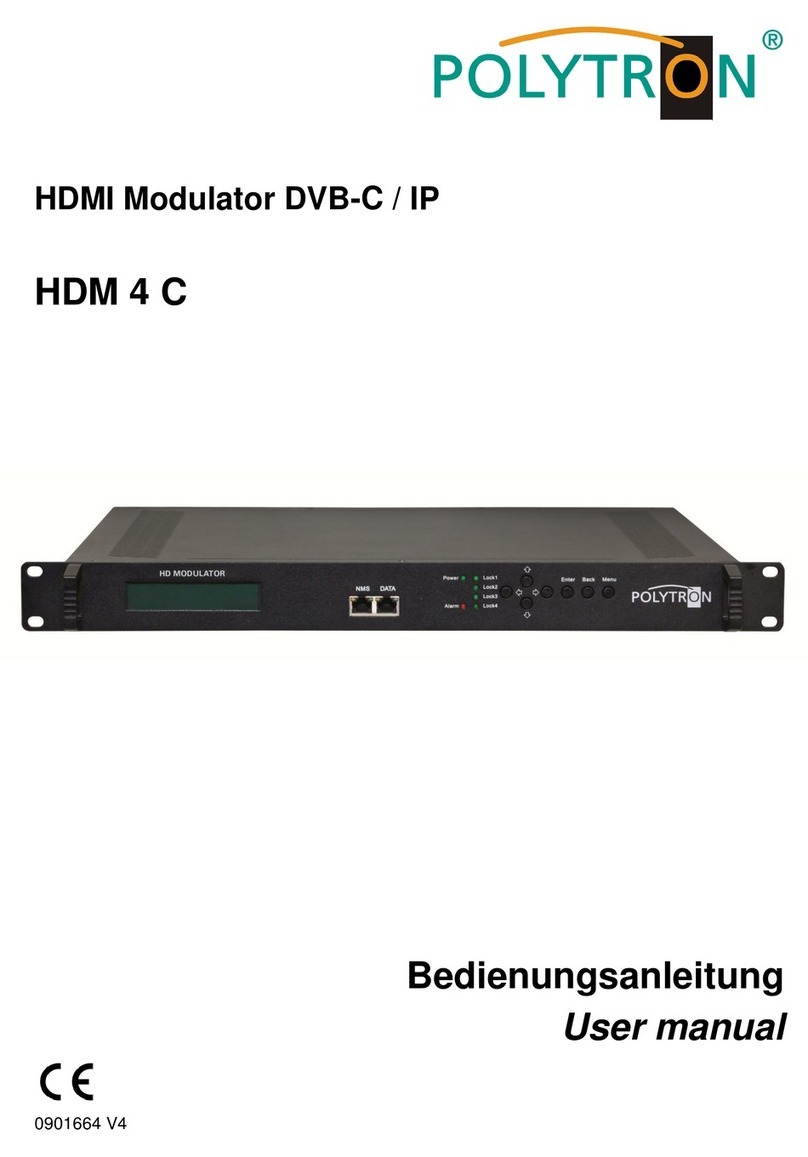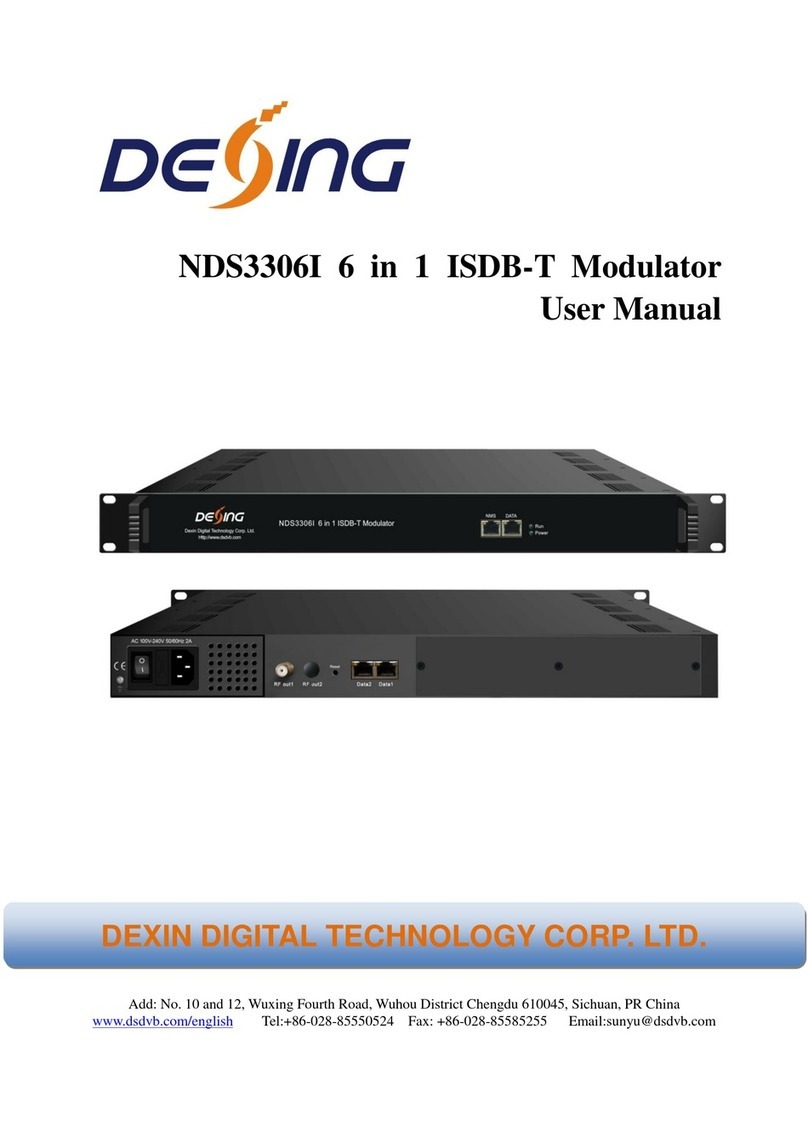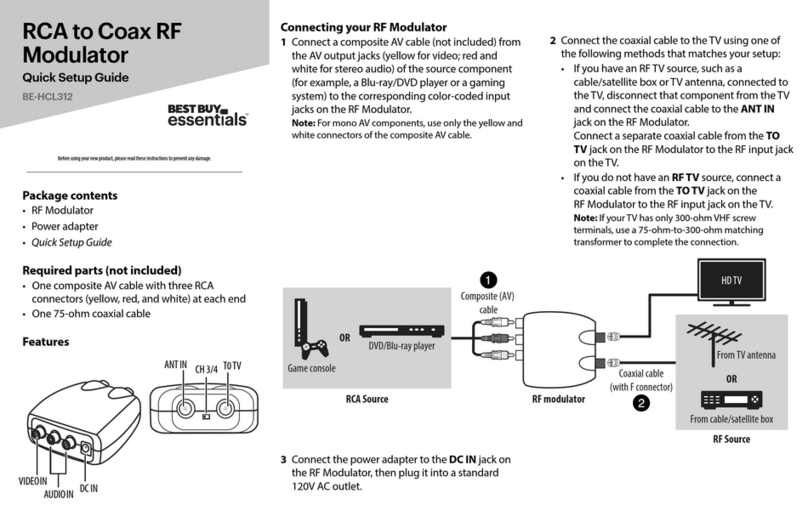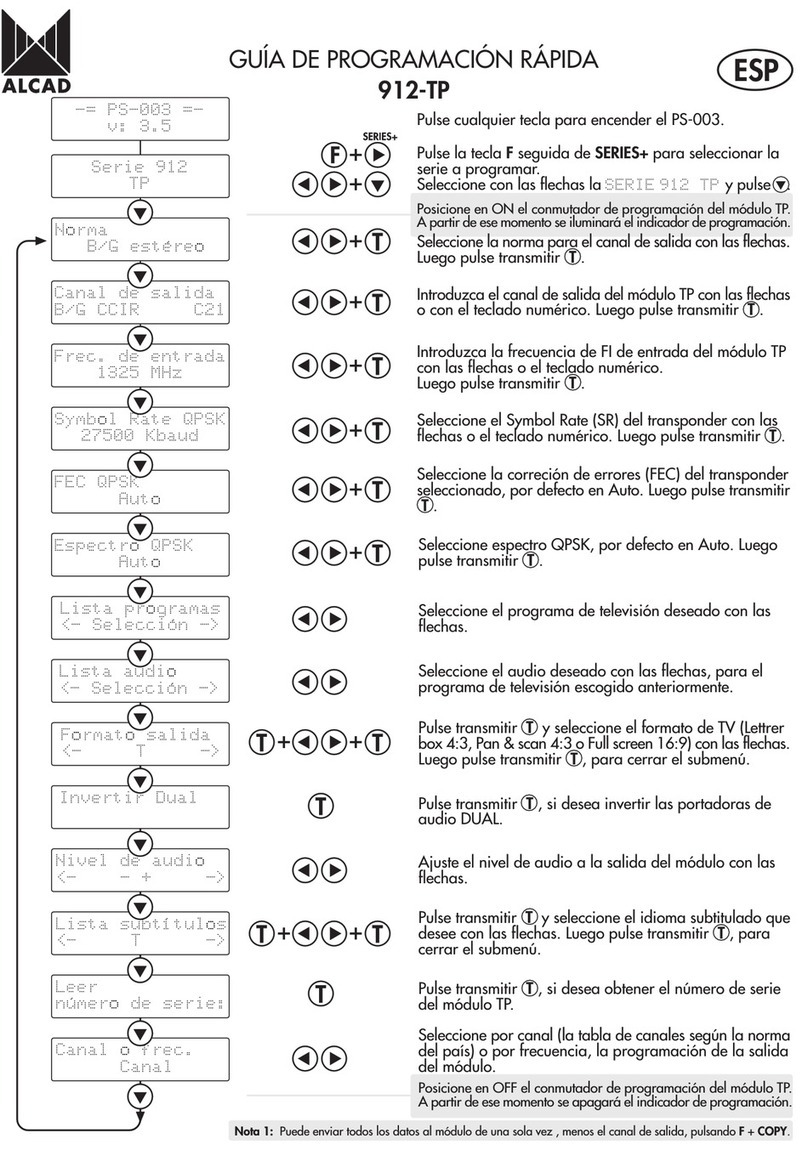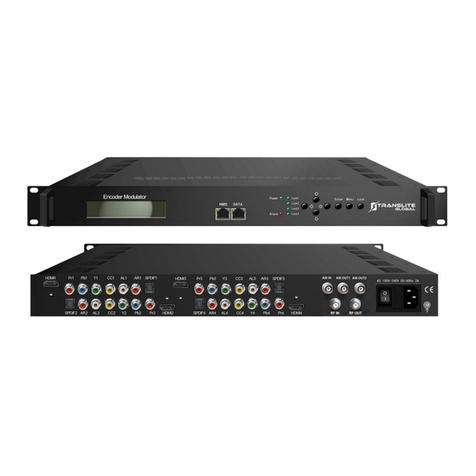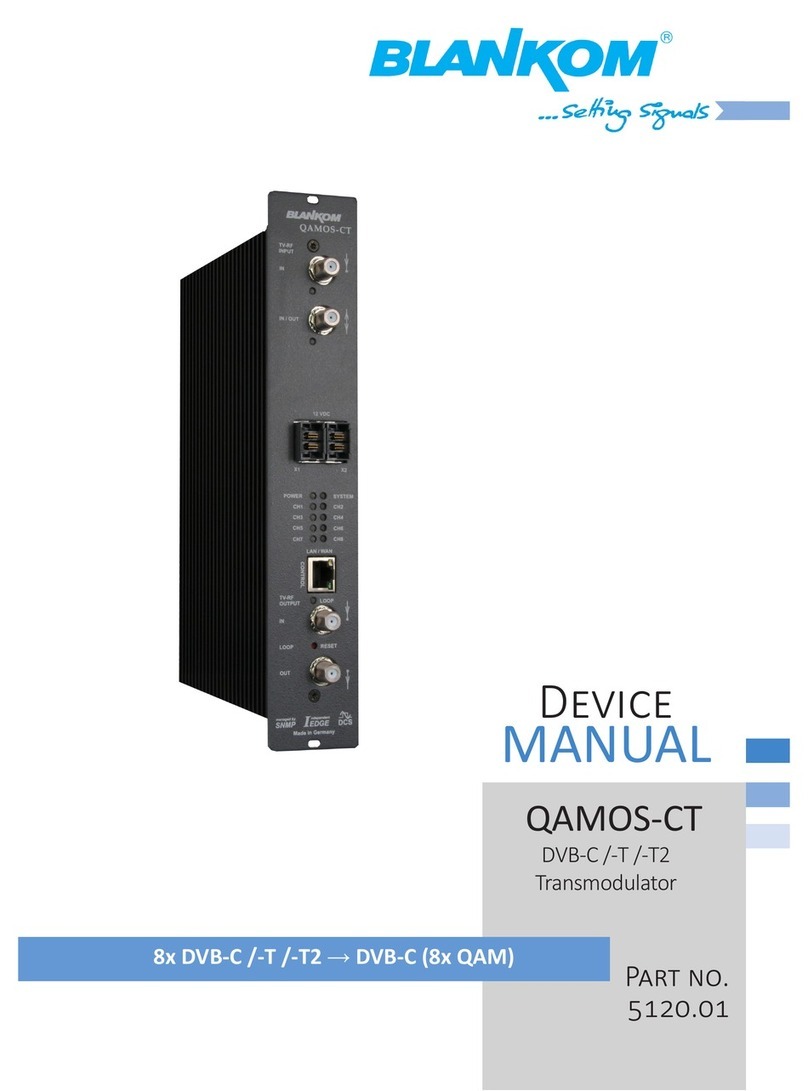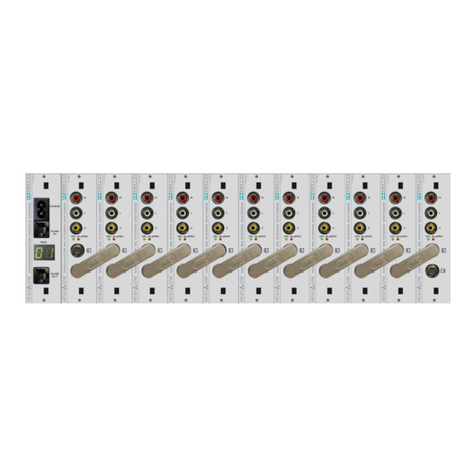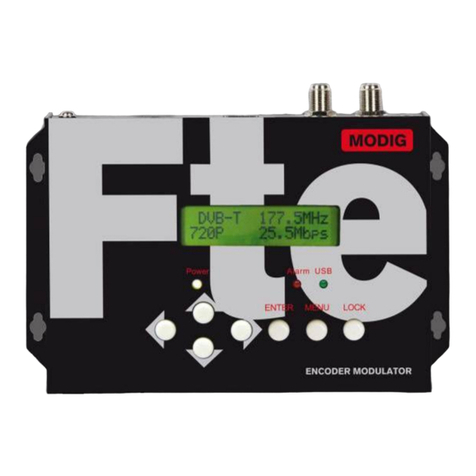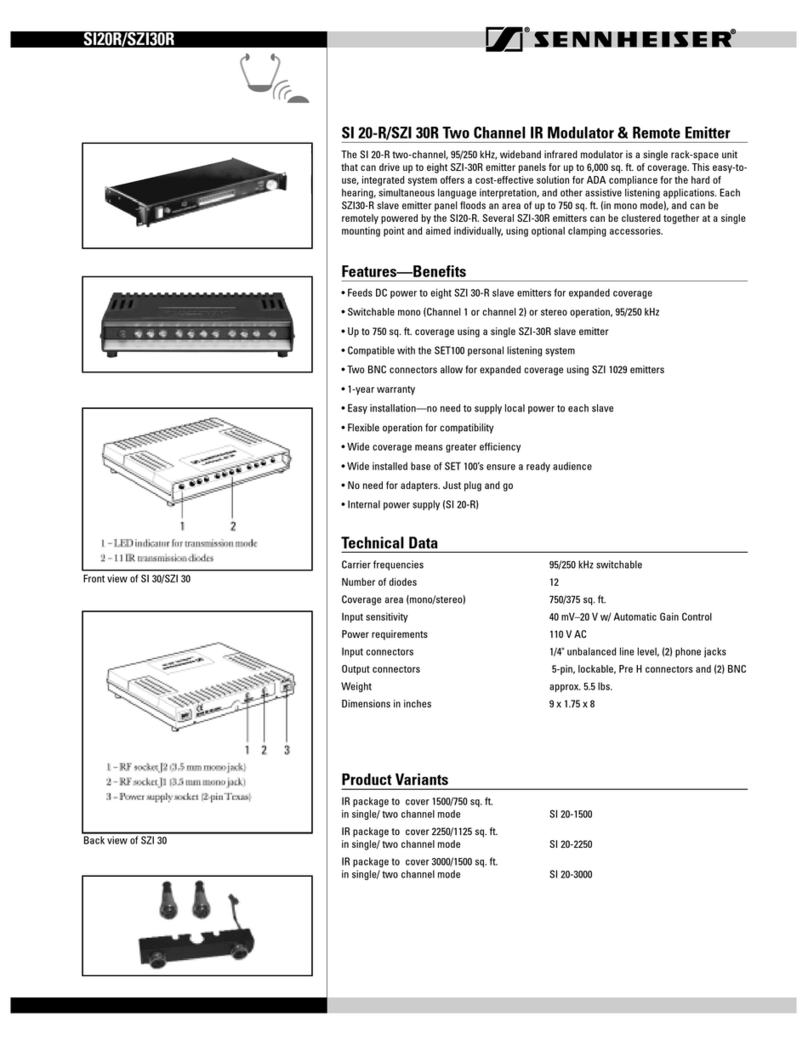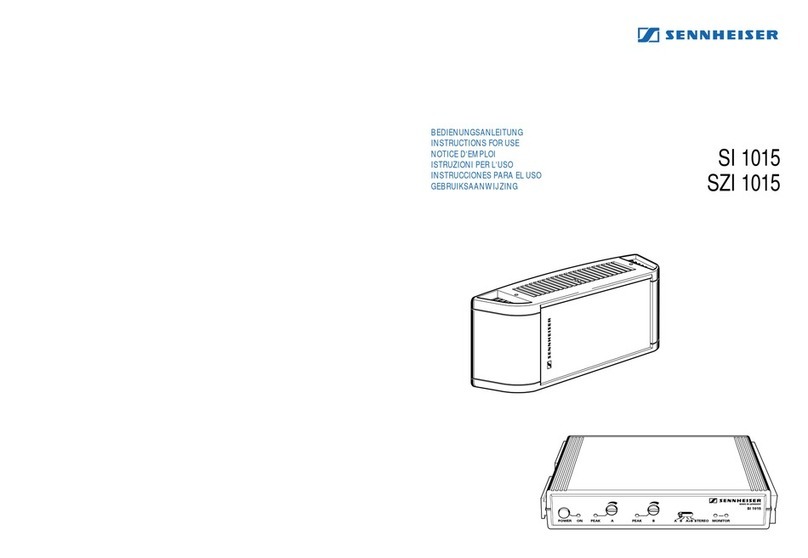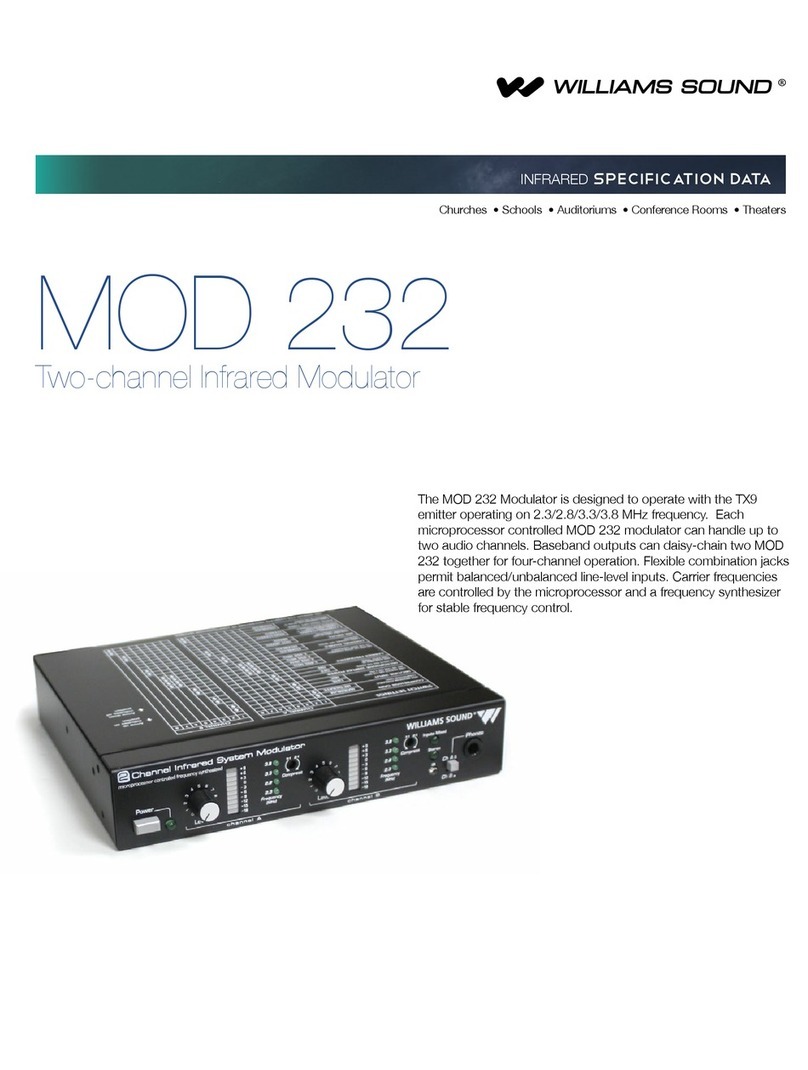Data-Tronix DT-NTSC-32 User manual

Manual
DT-NTSC-32
User Manual

2
DT-NTSC-32 Manual
Safety Instructions
•Read this manual carefully before operating this device.
•Removal of device cover without permission may cause harm and void the warranty.
•Handle the device with care to avoid dropping, possibly causing damage to the internal
hardware parts.
•Keep all inflammable, metal and liquid materials away from the device housing, to avoid
causing damage to the device.
•Avoid installation in dusty places and places with heating resources nearby. Avoid
installation in direct projection of sunlight.
•Connect the grounding connector on the rear panel to protective earth contact properly
while in operation.
•Ensure the proper type of cable connectors are used for connecting network interfaces
of the device.
•Avoid rapid and frequent powering on/off, as it may cause damages to the
semiconductor chipsets.
•Keep proper direction of the power cord when plugging into or out of a power socket.
•Connect the grounding pole and signal cable before connecting the power cord.
•Do not touch the power socket with wet hands to avoid electric shock.
•Remove all jewelry, such as rings, necklaces, watches, bracelets, etc., before operating
this device. Failure to do so may lead to a possible short circuit and result in components
being damaged.
•Make sure the AC power is unplugged in case of operator services within the device
casing or close to power supply are needed.
•Only trained and approved staff are permitted to perform live line operation and
maintenance within the device casing.
•Ensure good ventilation while the device is in operation. Failure to do so may cause
damage to the device due to overheating.
•It is recommended to unplug the power cord from the socket if the device will not be
used for a long period of time.

3
DT-NTSC-32 Manual
Table of Contents
Safety Instructions ................................................................................................................ 2
Chapter 1 Product Overview.................................................................................................. 4
1.1 Key Features............................................................................................................ 4
1.2 Specifications........................................................................................................... 5
1.3 Appearance and Illustration ...................................................................................... 6
Front panel Illustration .............................................................................................. 6
Rear Panel Illustration:.............................................................................................. 6
Chapter 2 Installation Guide .................................................................................................. 7
2.1 Acquisition Check..................................................................................................... 7
2.2 Installation Preparation ............................................................................................. 7
2.2.2 Environment Requirement...................................................................................... 8
2.2.3 Grounding Requirement......................................................................................... 8
2.2.4 Frame Grounding .................................................................................................. 9
2.2.5 Device Grounding.................................................................................................. 9
2.3 Wire’s Connection .................................................................................................... 9
2.3.1 Power cord connection .......................................................................................... 9
Chapter 3 W eb NMS Management ...................................................................................... 10
3.1 Login ..................................................................................................................... 11
3.2 Operation ............................................................................................................... 11
3.2.1 Summary ............................................................................................................ 11
3.2.2 Parameters .................................................................................................... 12-15
3.2.3 System........................................................................................................... 16-19
Chapter 4 Troubleshooting .................................................................................................. 20
Chapter 5 Packing list ......................................................................................................... 21
DataTronix W arranty ...................................................................................................... 21-22

4
DT-NTSC-32 Manual
Chapter 1 Product Overview
The DataTronix DT-NTSC-32 takes digital video signals from an IP source, such as a COM3000
or DT-ATSC-IP-8V2 and converts the IP source to analog modulated NTSC TV channels. This
unit can output up to 32 NTSC channels. It solves a common problem for senior living housing
and any other commercial properties that may still have some analog TV's on site, or digital
TV’s not capable of decoding certain video formats. It can receive and decode multiple HD or
SD IP video streams in either MPEG-2, MPEG-4, H.264 or H.265 format. This modulator
supports numerous audio formats that can be decoded and reformatted for NTSC analog
modulated TV channels. This unit is perfect for the following use cases:
Low income properties wanting free off-airTV service in NTSC analog can use the DataTronix
DT-ATSC-IP-8V2 to receive and convert the off-air signals to IP, then use the DT-NTSC-32 to
modulate them onto NTSC analog TV channels.
Properties receiving satellite TV with a DIRECTV COM3000 can connect the DT-NTSC-32 to
modulate 32 satellite channels onto NTSC analog TV channels to support legacy televisions,
gym equipment, or other non-Pro:Idiom displays.
1.1 Key Features
•2 Gigabit Ethernet ports (max 64 IP input over MPTS/SPTS), Max 840Mbps for each
Gigabit Ethernet input
•Supports MPEG-2, MPEG-4, H.264 or H.265 Transport Stream (TS) Decapsulation
•Processing of up to 32 IP multicast groups from a Gigabit Ethernet MPEG TS into up to
32 standard NTSC TV programs.
•Supports Web-based Network management which allows for remote tuning of source
streams and NTSC channel outputs

5
DT-NTSC-32 Manual
1.2 Specifications
Network Interface
Management 1 x 100 Base-T Ethernet (RJ 45)
Data
2 x 1000 Base-T Ethernet (RJ 45)
Protocol
IEEE802.3 Ethernet, RTP, ARP, IPv4,
TCP/ UDP,
HTTP, IGMPv2/v3
Input
Types 2 GE ports (max 64 IP input)
Max 840Mbps for each GE input
Stream UDP, UDP / RTP, 1-7 packets, FEC,
SPTS, MPTS
Transport Protocol TS over UDP/RTP, unicast and multicast,
IGMP V2/V3
Packet Length 188/204 Bytes
Decoding Parameters
Video 4 mm
Audio F2.0
Data Fixed
Resolution
MPEG-2 1080@60I, 1080@50I, 720@60P,
720@50P, 576@50I, 480@60I
H.265/H.264 1080@60P ,1080@60I, 1080@50P,
1080@50I, 720@60P, 720@50P
Aspect Ratio 4:3/16:9
Others
CNR (after internal
combining) 60 dB
SNR (after internal
combining)
> 53 dB
Sampling
frequency
48, 44.1, 32
Output Volume
Adjustment 0 - 100 %
Image Resolution
Output 480i/576i
OSD
logo: JPG, BMP, PNG
CAPTION: support multiple languages,
scrolling direction and speed customized
Modulation Parameters
Number of
Channels
up to 32
Connectors 75Ω, F-jack
Frequency Range 43.25 – 951.25MHz, Digital Modulation
Output Level Maximum 112dBμV
Return Loss ≥ 14dB
Spurious
Frequency
Distribution
≥ 60dB
Stereo Crosstalk > 55dB
Residual Carrier
Accuracy
1%
General
Operating
Temperature
32 - 113°F (0 to 45°C)
Storage
temperature
-4 - 176°F (-20 - 80°C)
Power Supply AC100V±10%, 50/60Hz or AC
220V±10%,50/60Hz
Dimensions 16.53” x 17.32” x 1.75” (420 x 440 x
44.5mm)
Weight 9.12 lbs (4.14 kg)
Warranty 1-Year Limited Warranty
WEB Interface (TV Standard)
TV Standard
NTSC
Video-Signal
to Noise Ratio
≥ 60dB

6
DT-NTSC-32 Manual
1.3 Appearance and Illustration
Front panel Illustration
Rear Panel Illustration:
No.
Description
1
NMS: network management port
2
Power Indicator
3
Grounding
4
AC Power Socket
5
Power switch
6
Data Input
7
RF output port
8
RF Test
2
1
3
4
6
7
5
8

7
DT-NTSC-32 Manual
Chapter 2 Installation Guide
2.1 Acquisition Check
When opening the device package, it is necessary to check items according to the packing list.
It should include the following items:
• DT-NTSC-32 32 in 1 IP to Analog Modulator
• User’s Manual
• Power Cord
If any item is missing or mismatching with the list above,
please contact NACE Support at 800-688-9282.
2.2 Installation Preparation
When installing the device, please follow the below steps. The details of installation will be
described in this chapter. Users can also refer to the rear panel chart during the installation.
The main steps of the installation include:
1. Checking for possible damage during the transportation and missing contents
2. Preparing relevant environment for installation
3. Installing DT-NTSC-32 in 1 IP to Analog Modulator
4. Connecting signal cables
5. Connecting communication port (if necessary)
2.2.1 Device’s Installation Flow Chart Illustrated as follows:

8
DT-NTSC-32 Manual
2.2.2 Environment Requirement
2.2.3 Grounding Requirement
All function modules’ good grounding is the basis of reliability and stability of devices. Also, they
are the most important guarantee of lightning arresting and interference rejection. Therefore, the
system must follow this rule.
Coaxial cables’ outer conductor and isolation layer should keep proper electric conducting with
the metal housing of the device.
Grounding conductors must adopt copper conductors in order to reduce high frequency
impedance, and the grounding wire must be as thick and short as possible.
Item
Requirements
Machine
Hall Space
When a user installs a machine frame array in one machine hall, the
distance between 2 rows of machine frames should be 3.93 – 4.92 Ft.
(1.2 - 1.5m) and the distance against the wall should be no less than
2.62 Ft. (0.8m).
Machine
Hall Floor
Electric Isolation, Dust Free
Volume resistivity of ground anti-static material: 1 x 107– 1 x 1010^,
Grounding current limiting resistance: 3.28 Ft.(1M) (Floor bearing should be
greater than 1186.51 lb/yd2(450Kg/㎡
)
)
Environment
Temperature
41- 104°F (5 - 40°C) (sustainable), 32- 113°F (0 - 45°C) (short time)
installing air-conditioning is recommended
Relative
Humidity 20% - 80% sustainable 10% - 90% short time
Pressure 12.47 – 15.22 PSI (86 - 105KPa)
Door &
Window
Installing rubber strip for sealing door-gaps and
dual level glasses for window
Wall It can be covered with wallpaper, or brightness less paint.
Fire
Protection Fire alarm system and extinguisher
Power
Required device power, air-conditioning power and lighting power are
independent of each other. Device power requires AC power 220V ±10%
50/60Hz or 110V ±10% 50/60Hz. Please carefully check before running.

9
DT-NTSC-32 Manual
Users should make sure the 2 ends of grounding wire are well electrically conducted and be
anti-rust.
It is prohibited to use any other device as part of grounding electric circuit
The area of the conduction between grounding wire and device’s frame should be no less than
4 AWG (25mm2).
Please refer to Article 100 of the NEC for all grounding related items
2.2.4 Frame Grounding
All the machine frames should be connected with protective copper strips. The grounding wire
should be as short as possible and avoid circling. The area of the conduction between
grounding wire and grounding strip should be no less than 4 AW G (25mm2).
2.2.5 Device Grounding
Connecting the device’s grounding rod to the frame's grounding pole with copper wire.
2.3 Wire’s Connection
2.3.1 Power cord connection
The power socket is located on the right of the rear panel, as is the power switch. Plug one end
of the power cord to the socket and insert the other end to AC power. When the device solely
connects to protective ground, it should adopt an independent way, say, share the same ground
with other devices. When the device adopts a united way, the grounding resistance should be
smaller than 1Ω.
Caution: Before connecting power cord to DT-NTSC-32, users should set the power
switch to “OFF”.

10
DT-NTSC-32 Manual
Chapter 3 Web NMS Management
This device does not support LCD operation, and all modifications must be done via the Web
interface.
3.1 Login
The factory default IP address is 192.168.0.136 and users can connect the device and web GUI
through this IP address.
1. Connect the PC and the device with a network cable.
2. Launch the web browser and input the device IP address in the browser’s address bar
and press enter.
3. It displays the Login interface as Figure-1. Input the Username and Password (Both the
default Username and Password are “admin”. And then click “Login” to start the device
setting.
Figure-1

11
DT-NTSC-32 Manual
3.2 Operation
3.2.1 Summary
Once logged in, you will see the Summary Interface screen as shown in Figure-2.
Figure-2

12
DT-NTSC-32 Manual
3.2.2 Parameters
Parameters → IP Input:
Clicking “IP Input”, will display the interface as shown in Figure-3. Users can select the output
TS channels.
Click “+” to add IP input, and then select one channel to parse. It will display the interface where
users can choose the programs to output.
Figure-3
: To add input channel which come from Data1 or Data 2 or Data Module (front panel)
: To edit the input channel
: To delete the input channel
: To delete all inputs channel
Output Area
Input Area

13
DT-NTSC-32 Manual
Figure-3.1
1. To refresh the input program information
2. To refresh the output program information
3. Select one input program first and click this button to transfer the selected program
to the right box to output.
4. Similarly, users can cancel the multiplexed programs from the right box.
5. To select all the input programs
6. To select all the output programs
7. To parse programs time limitation of parsing input programs
1
2
3
4
5
6
7

14
DT-NTSC-32 Manual
Parameters → Modulator:
Clicking “Modulator”, will display the interface as shown in Figure-4. Allows the user to make
changes to the RF output by frequency.
Figure-4
NTSC standard

15
DT-NTSC-32 Manual
Parameters → Decoder:
This function allows the user to monitor the status of decoding. It displays the interface as
shown in Figure-5.
Figure-5

16
DT-NTSC-32 Manual
3.2.3 System
System → Network:
Allows network parameters to be defined.. as shown in Figure -6
Figure-6
System → Account:
Allows the user to set the login Username and password for the web NMS as shown in Figure-7
Figure-7
Set data port IP address
To modify IP input address

17
DT-NTSC-32 Manual
System → Configuration:
Allows user defined actions such as “restore”, “backup” and “Factory Default” as shown in
Figure-8
System → Closed captioning(CC):
Closed captioning(CC) can be enabled by selecting IP input, and navigating to the
corresponding input, as seen in Figure-9
Figure-9
Select areas

18
DT-NTSC-32 Manual
System → Firmware:
Firmware updates are done by clicking on “Firmware” as seen in Figure-10
Figure-10
System → Log:
Click “Log”, allows the user to view log entries as seen in Figure-11.
Figure-11
To select “Kernel log” and “System Log”

19
DT-NTSC-32 Manual
System → Reboot:
Click “Reboot”, it displays the screen as Figure-12 where to check the “Reboot”.
Figure-12

20
DT-NTSC-32 Manual
Chapter 4 Troubleshooting
Our ISO9001 quality assurance system has been approved by the CQC organization to
guarantee the products quality, reliability and stability. All products have passed the testing and
inspection before shipping out of the factory. The testing and inspection scheme covers all the
Optical, Electronic and Mechanical criteria which have been published by us. To prevent
potential hazards, please strictly follow the operation conditions.
Prevention Measure
1. Install this device in an environment where temperature is between
32° - 113° F (0 to 45 °C)
2. Make sure there is good ventilation for the heat-sink on the rear panel
3. Check AC voltage input and be sure the power supply is correct
before switching on device
4. Check the RF output level range
5. Checking all signal cables have been properly connected
6. Frequent switching on/off of the device is prohibited; the interval between every power
cycle on/off must be greater than 10 seconds.
It is recommended to unplug the power cord if any of the following events occur:
• Power cord or socket is damaged.
• Accidental spill
• Any short circuiting
• Device is stored in a damp environment
• Device has suffered from physical damage
• It is also recommended to unplug power if the unit will be sitting for an extended period
of time.
Table of contents
Other Data-Tronix Modulator manuals
